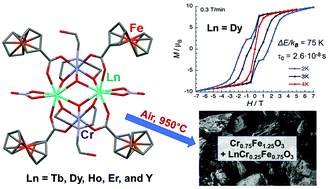Tetranuclear Cr–Ln ferrocenecarboxylate complexes with a defect-dicubane structure: synthesis, magnetism, and thermolysis†
Abstract
Using ferrocenecarboxylic acid (FcCO2H) and triethanolamine (H3tea) as ligands, the isostructural heterotrimetallic complexes [LnIII2CrIII2(OH)2(FcCO2)4(NO3)2(Htea)2]·2MePh·2THF (Ln = Tb (1), Dy (2), Ho (3), Er (4), and Y (5); Fc = (η5-C5H4)(η5-C5H5)Fe; H3tea = N(CH2CH2OH)3) were obtained. In all of the complexes which possess a defective dicubane structure, two doubly deprotonated triethanolamine ligands chelate the chromium ions. However, during the synthesis of 1, an isomeric complex 1a in which Tb3+ is chelated by triethanolamine as a tetradentate ligand, was also isolated as a few single crystals. Magnetic susceptibility measurements revealed dominant antiferromagnetic interactions in the {LnIII2CrIII2} cores of 1–4 leading to the formation of complexes with an uncompensated magnetic moment, while weak Cr–Cr ferromagnetic interactions were detected in the Y analogue. Complexes 1, 2, and 3 exhibit single-molecule magnet properties dominated by an Orbach-type relaxation mechanism with magnetization reversal barriers (Δ/kB) estimated around 54, 75, and 47 K, respectively. The Dy complex exhibits a magnetization hysteresis in an applied magnetic field at temperatures below 4 K. Thermolysis of the complexes was studied by TGA and DSC techniques; the final products obtained under an air atmosphere contain mixed oxide Cr0.75Fe1.25O3 and heterotrimetallic oxide LnCr1−xFexO3 (with x ≈ 0.75) phases.



 Please wait while we load your content...
Please wait while we load your content...